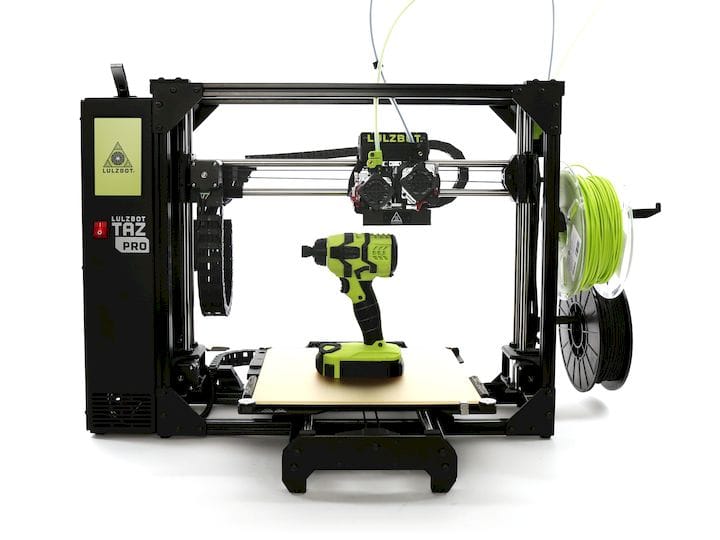![The new LulzBot TAZ Pro desktop 3D printer [Source: Aleph Objects]](https://fabbaloo.com/wp-content/uploads/2020/05/lulzbot-taz-pro-ov_result_img_5eb09a12618f3.jpg)
Aleph Objects has ventured into new territory with the announcement of their new TAZ Pro device.
The Colorado-based company has long been producing desktop equipment, primarily for the hobbyist and prosumer market. Their equipment has always been very well-regarded and their commitment to open source practices is widely admired.
But there’s only so far one can go in those markets, as has been discovered by most desktop 3D printer manufacturers. Most of the lesser manufacturers in this category have pivoted towards what we call the “professional market”, where a smaller, but higher-paying group of architects, designers and engineers require access to 3D printing at a higher grade than the consumer-style machines we’ve often seen.
These pivots have been quite successful in many cases, with perhaps Ultimaker being the most prominent.
Now it seems that Aleph Objects is shifting a bit in that direction along with the others with their new TAZ Pro.
Let’s take a look at the TAZ Pro, which is clearly based on their prior machines, but with some extra bits that transform it into a professional-level machine.
The major feature on the device is the multi-material capability. This enables worry-free 3D printing of highly complex objects when the second extruder uses soluble support material. This material is easily dissolved away in a passive manner, making printed part cleanup tremendously easy.
But the LulzBot machine goes a bit farther, suggesting that the second extruder can also be used for other materials. While some would boast of the ability to 3D print, say, in multiple colors, that’s of little use to most professionals. Instead, Aleph Objects points out that the TAZ Pro is able to 3D print in flexible or other engineering materials on the second extruder.
This could permit, for example, the printing of an object with hard and soft components. Imagine a toothbrush with an overmolded handle for easy gripping. Or, don’t imagine, just look at the prototype hand drill Aleph Objects 3D printed in the image at top. That’s a very powerful capability.
Aleph Objects has also beefed up other aspects of the machine to ensure robustness and print quality, including: a belt-driven Z-axis to reduce wobble; filament-out sensors and processing; “enhanced electronics” that seem to work far faster; larger control panel; full automation, such as calibration, nozzle wiping and more.
The TAZ Pro also provides a rather generous build volume of 280 x 280 x 285 mm, one of the larger machines in the professional category.
There’s one thing that’s bothering me, however, and that is that Aleph Objects has termed the TAZ Pro as an “Industrial” machine. For me, “Industrial” would require a few more features that focus on production aspects, such as continuous operation, on-the-fly material re-supply, administrative job tracking, and more. Meanwhile, Aleph Objects says the TAZ Pro will come with an air-filtered enclosure later this year, which takes a step towards “industrialization”.
However, as we see it for now, the LulzBot TAZ Pro is more of a professional-level machine than an industrial machine.
That said, it’s still going to be a fabulous option for many professionals. Aleph Objects says the machine is priced at US$4,950 for pre-order now.
Via LulzBot











FELIXprinters has released a new bioprinter, the FELIX BIOprinter, which is quite a change for the long-time 3D printer manufacturer.